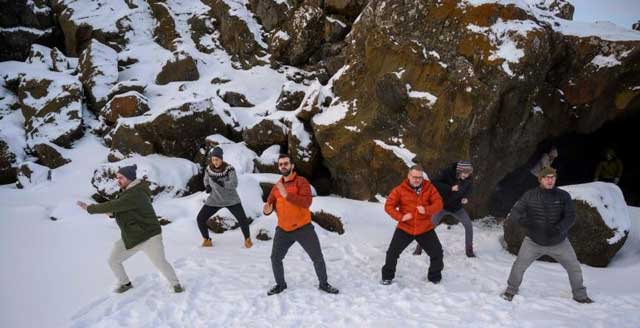
Grindavik, Iceland | AFP | Using slow, deliberate movements and deep breathing, bathers immerse themselves in the waters of an ice-covered lake in southwestern Iceland.
While others might opt for the soothing hot springs for which the country is famous, this hardy group prefers an ice bath, all in the name of wellness.
The temperature above the frozen lake of Kleifarvatn, one of the country’s deepest, is minus six degrees Celsius (21.2 degrees Fahrenheit).
Equipped with an axe, Andri Einarsson, the co-instructor on this unusual seminar, cuts a hole through the sheet of ice covering the lake, located less than an hour’s drive from the famous Blue Lagoon geothermal spa whose milky blue waters average 38 degrees C.
Up on shore, the group of about 15, who have come from the outskirts of the capital Reykjavik, is getting ready.
Clad in puffer jackets or thick sweaters, the participants warm up with a series of movements and breathing exercises reminiscent of the traditional Maori haka war dance.
“They were just working on getting the system ready (for the cold), challenging their mind, just tapping in and doing what we call the ‘brown fat activation’,” Einarsson tells AFP.
– Cold as a remedy –
The breathing technique is one of the pillars of the Wim Hof Method, named after a Dutch athlete.
Nicknamed the “Iceman,” Wim Hof has been setting world records and pursuing extraordinary feats of cold resistance for decades.
In 2007, he climbed to an altitude of 7,400 metres (24,278 feet) on Mount Everest dressed only in shorts, and he’s completed a barefoot half-marathon north of the Arctic Circle.
He lauds the benefits of his cold therapy — which combines breathing techniques, exposure to cold and meditation — as helping combat fatigue and stress and strengthening the immune system.
On the Kleifarvatn shore, despite the freezing cold, one by one the jackets and sweaters are discarded in favour of swimwear, and the participants begin to take the plunge.
Many don’t even hesitate — the exercise marks the end of a four-week programme in which they’ve progressively been exposed to the cold.
It began with water at 10 degrees, followed by a bath full of ice, before finally braving the frozen lake.
For two minutes they endure the icy water, concentrating on inhaling and exhaling, which according to the adepts is the key to ignoring the biting pangs of the freezing temperatures.
Once out, walking back to dry land presents another challenge, as the cold water makes most people’s legs go numb.
“There is this feeling of needles and everything starts itching a little bit,” Marco Pizzolato tells AFP, as he returns from the hole in the ice.
– ‘All your worries’ –
When it comes to pain relief, the benefits of cold exposure have been known about since ancient times.
However the practice has been gaining popularity among athletes for the last 15 years to help them recover faster from workouts and injuries.
Scientists however are not yet fully convinced.
“We need more research before we can say for sure that it helps,” Haukur Bjornsson, a doctor with the Icelandic national football team, tells AFP.
“Cold water immersion is part of what is recommended to help with the recovery. But the most important thing is sleep and nutrition, those are the only things for which we have some strong scientific proof,” Bjornsson adds.
Different forms of cold therapy have found favour among the general public in recent years, with health clinics offering cryotherapy and fitness blogs preaching the benefits of cold showers.
Most public baths now too offer pools with water between two and 10 degrees C.
But Andri Einarsson stresses that it takes practice to actually enjoy the experience.
“Everybody can go in an ice bath, sit there and… be tough. But surrendering to it is totally a whole other ball game,” he says.
While the science of the Wim Hof Method is still not understood or universally accepted, those participants questioned by AFP swore by its merits.
Ingvar Christiansen said that the practice “completely changed (his) life and way of thinking,” as he recovered from a trying time in his life where he battled weight, burnout and divorce proceedings.
He now prefers cold baths to vacationing abroad.
“When I got out, I felt like I was coming home from a two-week vacation in Spain. You dump everything: all your worries, all your anxiety, it goes away.”
 The Independent Uganda: You get the Truth we Pay the Price
The Independent Uganda: You get the Truth we Pay the Price



